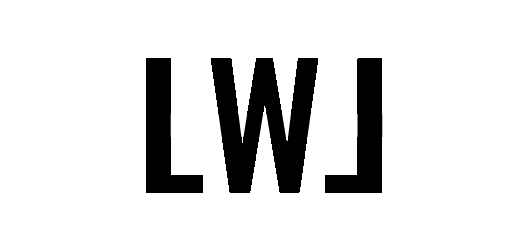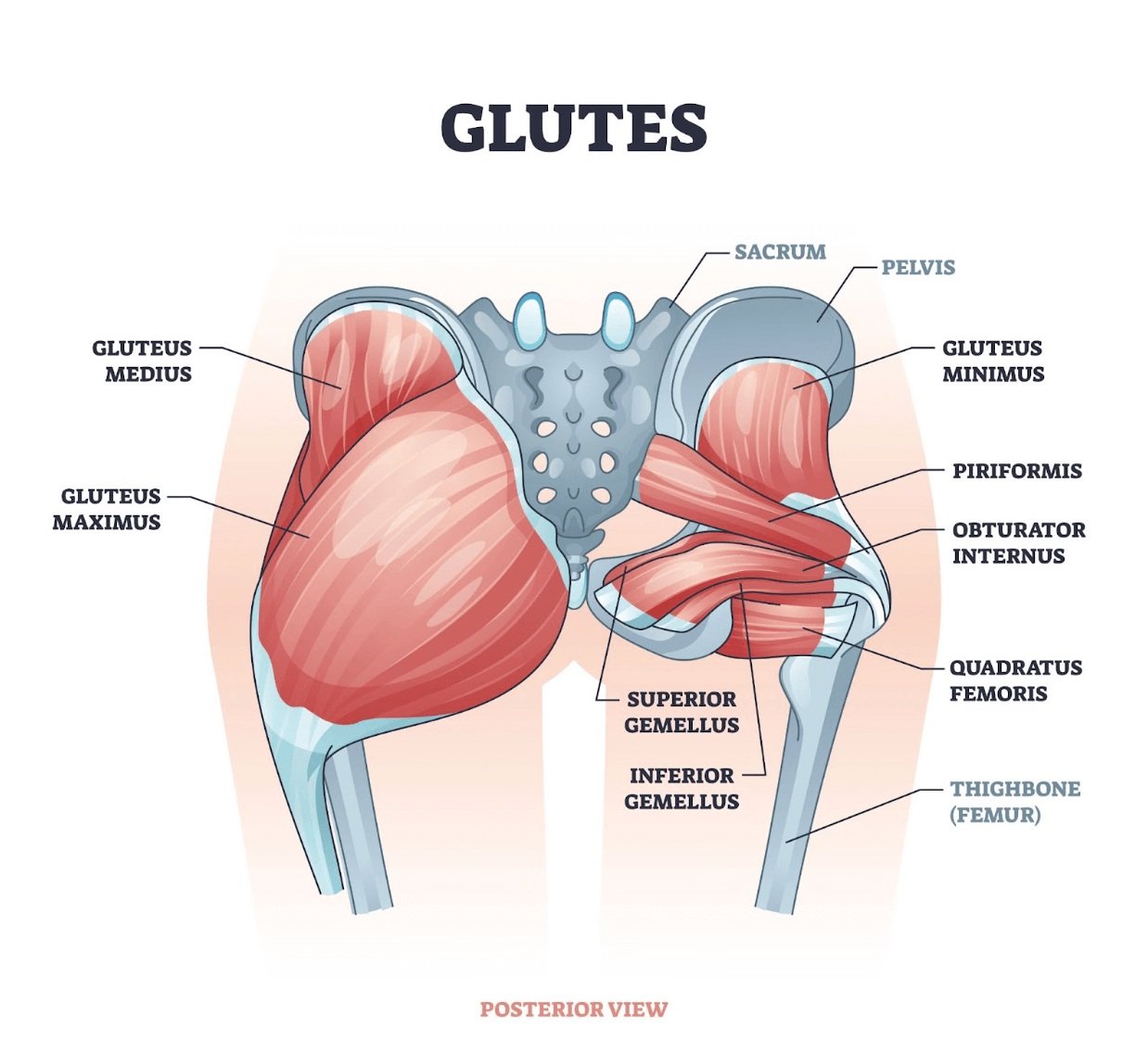The Best Glute Exercises to Build an Upper Butt
When clients come to us with booty goals, it’s often not just to increase the size of their bum, but also to create more of a rounder, bubble butt, shape. There are genetic differences that determine the look and shape of your derrière, including your skeletal structure and where you store fat.
While we cannot choose where our body stores fat, we CAN target specific muscle groups and prioritize muscle growth to build curves where we want them. So through training, we actually can achieve a bigger, rounder donk. One area we don’t want to neglect is our upper glutes!
In order to educate you responsibly, I want you to understand some basic anatomy, the musculature of a booty and best practices for how to implement upper glute work into your training program.
Pelvic and Upper Glute Anatomy
You’ve probably heard your butt muscles are known as your “Glutes”. More specifically, your glutes are composed of three gluteal muscles, The Gluteus Maximus, Gluteus Medius, and Gluteus Minimus (Glute Max, Med, Min for short).
The glute med and the upper subdivision of the glute max are the muscles of the upper glute that we can target to help give that booty “shelf” appearance at the top of your glutes. Your glutes are responsible for hip extension, abduction, and external rotation.
In addition to your musculature, your skeletal anatomy also plays a major role in the look and shape of your glutes. The difference is that this is NOT something you can change.
Your sacral slope (the angle of your sacrum) will give you the appearance of a rounder or flatter booty. People with a larger sacral slope will naturally have more of the “shelf” booty look, while people with a smaller sacral slope will naturally have more of a flatter derriere.
I like to point this out because not everyone starts with the same anatomy to build off of, so building the shape you want may be harder or take longer, based on your anatomy. This is also why it is super important not to compare your body to other people with different anatomy, or compare your normal human body to the digitally and surgically altered “ideal” that we see so often on social media.
How to Work Your Upper Glutes
No muscle works in complete isolation, so when targeting our upper glutes, we are actually trying to target both our glute med AND our upper glute max. Hip abduction exercises and horizontally-loaded hip extension exercises target your upper glutes.
The glute med and upper glute max are the primary movers for abduction at the hip joint (aka moving your legs away from your midline). So in order to build up our upper glutes, we want to add abduction exercises, like a standing banded abduction, into our training protocols. This is easy to conceptualize when thinking of isolation exercises, but that alone won’t give you an upper-butt booty shelf. Compound lifts that target both the upper and lower section of our glutes are one of the biggest keys to building the glute size and shape you want.
It’s also worth noting that simply changing your stance, positioning or adding a band can also change the exercise to target your upper glutes more while performing major lifts. For example, If we perform a hip thrust with a wider stance and a mini band around our knees, we are emphasizing the work of the upper glutes within that lift.
Volume and Rep Range Protocols
Before diving into the movements, let’s talk a little about muscle growth. Muscle growth happens primarily through progressive overload, where we are challenging the muscle with progressively increasing demands to cause it to adapt and grow. However, since the goal is hypertrophy (growth of the muscle size), we aren’t just aiming for pure strength here. In order to increase muscle size, we need to implement a variety of rep ranges and loads to build our upper glutes.
The following exercises are listed in the order I would perform them at the gym, so this can be added to your program as its own “booty day” OR you can sprinkle these moves into your program throughout the week.
Priority 1: Compound Movements with Low Reps and Heavy Weight
The bulk of your muscle growth will happen through maximizing mechanical tension. The easiest way to think of this is lifting super heavy weights at low reps. High Load = High Mechanical Tension. Compound movements should be the main lifts you prioritize and start with in your training.
Barbell Hip Thrust
Start seated on the floor with your upper back against a box or a bench, roll the barbell on top of your hips, then bend your knees to scoot your heels back under your knees. With your eyes looking through your knees, ribs knitted in and core braced, flex your glutes to lift your hips up.
BARBELL GLUTE BRIDGE
Start lying on the floor with a barbell on your hips, knees bent and feet firmly planted on the ground. Keep your hands on the bar, just outside of hip-width, flex your glutes and lift your hips up.
Priority 2: Novelty, Eccentrics, Range of Motion, Feeling “sore” with Moderate Reps, and Moderate Weights
A smaller, but still important piece of muscle growth is muscle damage. You feel this when you feel sore a day or two after training. Soreness isn't the best indicator of a “good workout”. It is simply an indicator of muscle damage, as a result of novelty. Novelty can be achieved through eccentrics, increased range of motion, or a new exercise (or one you haven't done in a while).
People tend to misinterpret this goal, so to clarify to my clients I like to tell them that we’re aiming for “functional soreness”, where you can feel the muscles you worked, but you’re not debilitated. If you’re in so much pain that you can barely sit down on the toilet, or you’re sore for 6 days and can't work out, that’s TOO much soreness and ends up being counterproductive to our goal.
BANDED GLUTE FOCUSED 45 DEGREE Hyper
Loop a band around the center of the machine, lean your upper thighs against the pad and lean forward. Lower all the way down to loop the band around your shoulders. Flex your glutes and lift your torso up. Keep your upper back rounded to ensure that this move targets your glutes, not your low back.
Eccentric Cable Kickback
Attach an ankle cuff to a cable machine. Use your arms to brace against the cable machine. Lift your leg back and up, then control the eccentric by resisting the pull and slowly lowering your leg down for 4 seconds.
PRIORITY 3: FEEL THE “BURN” or “PUMP” WITH HIGH REPS and LIGHTER WEIGHT
The last piece of the puzzle is metabolic stress, which you feel when you feel your muscles burning or notice a pump. We achieve this through higher reps, lighter weight and shorter rest periods. Think of this as a burn out or finisher at the end of the workout. For glute training, mini bands are awesome tools to utilize here.
Knee Banded Side Lying Hip Raise With Abduction
Start in a modified side plank position, lift your top leg up as high as you can, then lower both your hip and top leg to the ground. Lift both your hips and top leg up, then lower both down. Use a miniband around your knees for an extra burn.
CLAMSHELL
Start lying on your side with your knees bent. Keep your feet connected, while you lift your top knee up and back, then lower back to touch your bottom knee. Use a miniband around your knees for an extra burn.
Don’t Neglect These Other Important Muscle Building Factors!
Having a solid training program is just one piece of the puzzle to building and maintaining muscle. If you’re not fueling and recovering well, you might not see the progress you want.
Nutrition: If you’re not eating enough protein or calories to build and maintain muscle, your glute growth will be limited. You should be eating at least maintenance calories, and at least 0.6 - 1g of protein/lb of bodyweight.
Recovery: Getting adequate sleep and taking days off are just as important as training. Your muscles need to repair and recover between training sessions. Don’t skimp out on sleep and don’t skip rest days.
Stress Management: When you are stressed, your body releases a hormone called cortisol. High levels of cortisol inhibits muscle growth. Reducing stressors in your life, and adding in moments of relaxation, practicing meditation, diaphragmatic breathing and getting out in nature can help activate your parasympathetic nervous system.
Sign Up For Personal Training With a Ladies Who Lift Coach Today!
Ready to get your best bum? Our coaches build training plans specifically for you and your goals. Sign up for a custom online training program today!
ABOUT the author
Amy is a Certified Personal Trainer and Holistic Health Coach. She loves helping women heal their relationship with their bodies, and with food. She guides women on a journey to feel strong, confident, and capable through weight lifting and intuitive eating. In her free time, she can be found taking long walks on the beach, petting dogs, or talking about politics.





